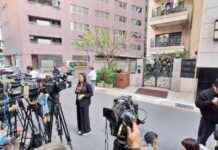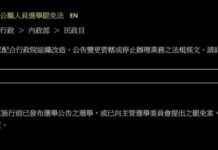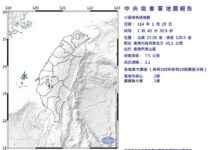Venezuela Election Protests: Over 700 Arrested, 12-Hour Blackout, Maduro Blames US and Fascists
Amidst the rapid advancement of technology, various applications beyond imagination can be seen in the highly anticipated “traffic” issue, where traces of modern technologies such as AI, 5G, big data are evident. In this episode, we invited Chang Hsin-fu, Director of the Taoyuan City Government’s Transportation Bureau, to share with us how the Taoyuan City Government is utilizing policies to strengthen the public transportation network and provide people with safer, more comfortable, and convenient transportation services through the assistance of smart technology, achieving the goal of an intelligent Taoyuan that puts people first. The Taoyuan City Government has pioneered the “training for employment” program, injecting new talent into bus driving! Due to the impact of an aging population and declining birth rates, Taiwan has long faced a shortage of bus drivers for passenger transport. After the outbreak of the COVID-19 pandemic, public transportation operations were reduced, bus services were significantly reduced, and many drivers did not return, exacerbating the already existing shortage of drivers. Chang Hsin-fu, Director of the Taoyuan City Government’s Transportation Bureau, admitted that despite the monthly salary of bus drivers reaching as high as 60,000 to 80,000 NT dollars, at the beginning of this year, the shortage of drivers in various counties and cities in Taiwan still amounted to 2,000 people, with Taoyuan City alone having a shortage of 250 drivers. The main reasons for this shortage are still the long working hours of drivers, the need for prolonged sitting, inflexible working hours, and the risk of customer complaints, traffic accidents, etc., making it difficult to attract young people to enter the industry, resulting in a talent pool that is drying up. In order to solve this generational problem, the Taoyuan City Government’s Transportation Bureau has formulated a “three-arrow” strategy of stabilizing the foundation, increasing revenue, and reducing expenses to address the thorny issue of driver shortages. First, the city government adjusts the budget to subsidize the passenger transport industry, reviews the operating costs of bus services, and improves the salary and treatment of drivers to improve the operating environment of buses to “stabilize the foundation,” avoiding the loss of existing talent. Next, the city government launched the “training for immediate employment” program for large bus drivers to “increase revenue,” providing favorable subsidy conditions to recruit new drivers and introducing the concept of technology industry retention bonuses in the program, designing a layered incentive mechanism to encourage participants to continue to stay in the program, avoid talent outflow from training, and achieve the effect of “reducing expenses.” Director Chang further explained, “The practices in other counties and cities require people to wait until they obtain a large bus driver’s license and start working before they can receive subsidies, but this will cause problems with people’s livelihoods during the training and testing period. So we have made some adjustments, matching people to serve at passenger transport companies during the training and testing period, with the city government covering basic salaries and training costs. In this way, not only can people reduce the upfront burden of entering the driving job, but also ensure that their livelihoods are not interrupted.” All in all, if ordinary people fully participate in the program, they can receive approximately 200,000 NT dollars in subsidies; if they are new immigrants or indigenous peoples, they can also receive additional bonuses, new immigrant workplace adaptation courses, and additional subsidies for savings insurance, etc. Looking at the registration situation, the “training for immediate employment” program has been very active. It was originally planned to recruit 200 drivers within 2 years, but as of February, more than 200 people have applied, and after screening, interviews, and matching, about 70 people have entered the training stage, with 8 people graduating from the driving school two weeks ago and entering the front line of driving work. Director Chang cited, “For example, the ‘Zhongfeng Express Line’ from Zhongli Pingzhen to Longtan has increased by nearly 30 trips a day, and the improvement in bus services is very noticeable. Even if only 70% of the participants eventually hit the road, it can effectively alleviate the transportation problems caused by the current shortage of drivers in Taoyuan.” Director Chang also called on major counties and cities to jointly promote the “training for immediate employment” program since the plan has been successfully implemented and verified in Taoyuan, and the power of local governments can be consolidated to allow more new drivers to enter the market, fundamentally solving the problem of driver shortages and avoiding competition among the few driver talents; on the other hand, he also hopes that the Ministry of Transportation and the Ministry of Labor will take the labor shortage problem in Taiwan seriously, consider labor shortages as normal, and propose a long-term policy direction to solve the problem. Taoyuan’s “bias left turn” design expanded: vehicle passage through intersections increased by 250%, providing a smoother people-oriented transportation experience! Taoyuan has a daily commuter population of up to 3.2 million, so in addition to the shortage of bus drivers, “traffic congestion” is actually another huge challenge that Taoyuan’s transportation faces. According to statistics, since Taoyuan was upgraded to a direct-administered city in 2014, the city’s population has grown from 2 million to 2.32 million, an increase of 12%, but the road area has increased by less than 1%. In this context, Director Chang believes that since the road area is limited, and the lengthy process of road construction is slow, the key to solving the problem is to maximize the use of road resources and traffic resources. Therefore, last year, the Transportation Bureau drew on the experience of Japan and began to promote the “bias left turn road smooth project,” hoping to solve the problem of urban road congestion. Director Chang said, “The biased left turn lane, also known as the ‘auxiliary driver left turn lane,’ means that there is a dashed line on the ground guiding vehicles forward a little to the left; the center line of the lane shifts from facing the center of the road to leaning towards the other side, hence the name ‘biased’ lane.” The first intersection in Taoyuan to undergo improvement with a biased left turn lane was at the intersection of Daxing West Road and Wenchung Road. Before the implementation of the biased left turn lane, the left turn lane at rush hour would even be jammed all the way back to National Freeway No. 2, with a journey taking up to 2 hours being a common occurrence; however, after the establishment of the biased left turn lane, the time spent in traffic was reduced by more than half, coupled with the optimization of the traffic light duration, it now takes only about 45 minutes to clear all the queued vehicles, with a significant improvement in efficiency. Clear roads are visible. With the precedent of the above intersection, the public also strongly supports the change to biased left turns, so the Taoyuan City Government continues to target other intersections with demand and conditions for transformation. “Last year, we installed biased left turn lanes at 100 intersections in Taoyuan City, and because there was a noticeable improvement in traffic flow, this year we changed the selection criteria from ‘intersections’ to ‘sections,’ choosing 10 major roads to be fully upgraded, with an additional 200 intersections for improvement,” added Director Chang. “In addition, Mayor Zhang also instructed that biased left turns should not be the sole responsibility of the Transportation Bureau, so we have also begun to collaborate with district offices and the Highway Bureau to promote it together, such as several intersections on Provincial Highway 1 under the jurisdiction of the Highway Bureau have also implemented biased left turns this year, with even more pronounced effects.” AI traffic signal control and technology enforcement: Safer, smarter, more sustainable intelligent transportation now in progress! With the evolution of information and communication technology, in addition to the hardware transformation of road markings, the city government is also actively introducing smart transportation-related technologies. Director Chang also shared that in the field of transportation, the application of smart technology is called the “intelligent transportation system (ITS),” where whether it’s AI, IoT, 5G, or big data, the application of these smart technologies can be implemented in three aspects: “Go Safe,” “Go Smart,” and “Go Green” in every governance process. “Go Safe” focuses on safety, such as ensuring the safety of road users, enforcing violations through technology, or smart detection combined with LED warning signs; “Go Smart” focuses on intelligence, such as the extensive use of license plate recognition, ground magnetic smart parking poles, or AI traffic signal control with real-time road condition detection calculations; and “Go Green” focuses on green transportation, such as the popular T-PASS, which is actually a large green transportation promotion project, or the recent active promotion of electric buses and U-Bike 2.0 in Taoyuan, all supported by a lot of smart technology, not as simple as it seems,” said Director Chang with a smile. Among them, the “Go Smart” direction involves the integration and application of many AI and 5G technologies. Director Chang used the AI traffic signal control project as an example, sharing, “In addition to using image recognition technology to obtain data such as traffic volume and turning vectors, AI traffic control also needs to integrate data and road scenarios through deep learning and reinforced learning, let AI calculate and then verify, so it can instantly calculate the appropriate traffic light duration and cycle in different situations.” He further added, “The main goal of this project is to prevent people from having to ‘wait for air,’ waiting at a red light when there are no cars around. Based on the early experiment at a single intersection, if it used to take 100 seconds to pass through the intersection, with AI traffic control implemented, it now only takes 70 seconds, an efficiency improvement of 30%.” Director Chang also specifically pointed out that some cities in the country only have AI traffic signal control equipped with front-end image recognition technology, with the back end using detected traffic volume, turning vectors, and Rule Based specific logic to match specific time delay tables; however, the AI traffic signal control system introduced by Taoyuan City uses AI for real-time calculations, making AI feel like it is computing the best solution from the entire dataset of Taoyuan City, allowing it to make the most immediate calculations and responses to different situations. Furthermore, Taoyuan initiated the AI traffic signal control project in 2019 and expanded the project scale from a single intersection to an entire road section in 2021; this year, with the assistance of the National Science Council’s Asia Silicon Valley Project grant, the government will further expand the scale, encompassing three areas: Taiwan Provincial Highway (Taoyuan to Zhongli), Zhongli Interchange Zhongyuan Road, and Dazhu Interchange Qingpu area, conducting more in-depth verification in multiple groups, multiple sections, and simultaneous operation modes, with the aim of providing Taoyuan residents with a smoother traffic environment and driving experience in the future. Another intelligent transportation application that deeply impressed Director Chang is the “technology enforcement” that Taoyuan City was the first in the country to implement in 2019. He recalled, “In the past, illegal parking was a serious problem at Neili Train Station, as long as there was a gap, people would continue to park illegally, and the police would receive numerous reports, having to make dozens of trips a day; then we used geophysical technology combined with image recognition cameras to enforce technology, and in about a week, no one dared to park there anymore because technology enforcement is 24/7, detecting, warning, taking photos, and issuing fines, no illegally parked car can get away.” Technology enforcement has also brought many positive benefits, with the most noticeable effect being the saving of police manpower, as officers used to make more than a dozen trips a day, but after technology enforcement, they only need to make a few patrols along the way, greatly reducing the laborious duties of police officers, and the public can also enjoy smoother road traffic, a truly wonderful win-win situation. Director Chang also emphasized that the application of smart transportation is not a panacea, each technology has its benefits and changes it brings, but different intersection problems and patterns are also different, and different issues must be addressed with different strategies. Like the cases he shared, if we want to achieve a truly sustainable and intelligent city that puts people first through the assistance of smart technology, one of the most important principles is to maximize the use of all resources. This has been the direction that the city government has been continuously striving for in recent years, combining technology while considering construction costs to achieve the most effective solutions.












